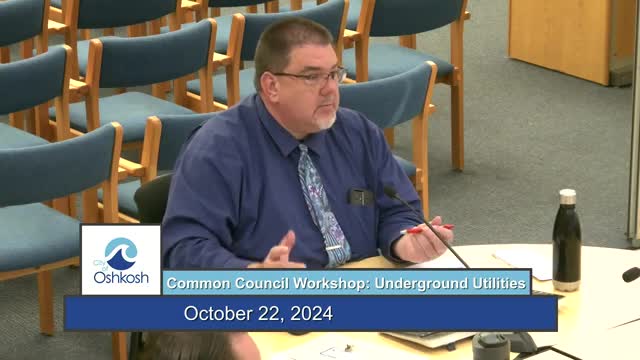Oshkosh explores underground utility installation to enhance neighborhood aesthetics and reliability
October 23, 2024 | Oshkosh City, Winnebago County, Wisconsin
This article was created by AI summarizing key points discussed. AI makes mistakes, so for full details and context, please refer to the video of the full meeting. Please report any errors so we can fix them. Report an error »

During the recent Oshkosh Common Council Workshop held on October 22, 2024, city officials engaged in a detailed discussion regarding the undergrounding of utilities, a topic that has significant implications for the community's infrastructure and aesthetics. The meeting aimed to explore the benefits and challenges associated with transitioning from overhead to underground utility systems, a move that could reshape the visual landscape of Oshkosh.
Historically, the idea of underground utilities dates back to the mid-1800s; however, early attempts were hindered by inadequate materials. Today, the city is served by a mix of utility providers, with Wisconsin Public Service (WPS) and AT&T sharing the responsibility for utility poles across Oshkosh. This unique distribution—approximately a 50-50 split between the two companies—sets Oshkosh apart from many other communities.
The council highlighted several advantages of underground utilities, including improved aesthetics, reduced tree maintenance, and decreased outage risks due to weather or wildlife interference. Underground systems are less vulnerable to damage, which can lead to lower operational and maintenance costs for utility companies in the long run. Additionally, the transition could facilitate easier navigation for oversized vehicles, reducing logistical challenges for transportation companies.
However, the discussion also illuminated significant challenges. The public right-of-way in Oshkosh is already congested with various underground utilities, including city services and multiple communication providers. This complexity complicates the feasibility of further undergrounding efforts, as space is limited and existing infrastructure must be carefully navigated.
The council's discussions were informed by community planning documents, including the Imagine Oshkosh plan, which identifies undergrounding utilities as a key goal. This alignment with broader planning initiatives underscores the community's commitment to enhancing the urban environment.
As the meeting concluded, city officials acknowledged the need for a comprehensive policy framework to guide future undergrounding projects. The next steps will involve further analysis of the costs and logistics associated with such initiatives, as well as continued engagement with community stakeholders to address concerns and gather input.
In summary, the Oshkosh Common Council's workshop on undergrounding utilities revealed a strong interest in improving the city's infrastructure while also recognizing the complexities involved. The discussions set the stage for future planning efforts that could significantly impact the community's landscape and utility management practices.
Historically, the idea of underground utilities dates back to the mid-1800s; however, early attempts were hindered by inadequate materials. Today, the city is served by a mix of utility providers, with Wisconsin Public Service (WPS) and AT&T sharing the responsibility for utility poles across Oshkosh. This unique distribution—approximately a 50-50 split between the two companies—sets Oshkosh apart from many other communities.
The council highlighted several advantages of underground utilities, including improved aesthetics, reduced tree maintenance, and decreased outage risks due to weather or wildlife interference. Underground systems are less vulnerable to damage, which can lead to lower operational and maintenance costs for utility companies in the long run. Additionally, the transition could facilitate easier navigation for oversized vehicles, reducing logistical challenges for transportation companies.
However, the discussion also illuminated significant challenges. The public right-of-way in Oshkosh is already congested with various underground utilities, including city services and multiple communication providers. This complexity complicates the feasibility of further undergrounding efforts, as space is limited and existing infrastructure must be carefully navigated.
The council's discussions were informed by community planning documents, including the Imagine Oshkosh plan, which identifies undergrounding utilities as a key goal. This alignment with broader planning initiatives underscores the community's commitment to enhancing the urban environment.
As the meeting concluded, city officials acknowledged the need for a comprehensive policy framework to guide future undergrounding projects. The next steps will involve further analysis of the costs and logistics associated with such initiatives, as well as continued engagement with community stakeholders to address concerns and gather input.
In summary, the Oshkosh Common Council's workshop on undergrounding utilities revealed a strong interest in improving the city's infrastructure while also recognizing the complexities involved. The discussions set the stage for future planning efforts that could significantly impact the community's landscape and utility management practices.
View full meeting
This article is based on a recent meeting—watch the full video and explore the complete transcript for deeper insights into the discussion.
View full meeting
